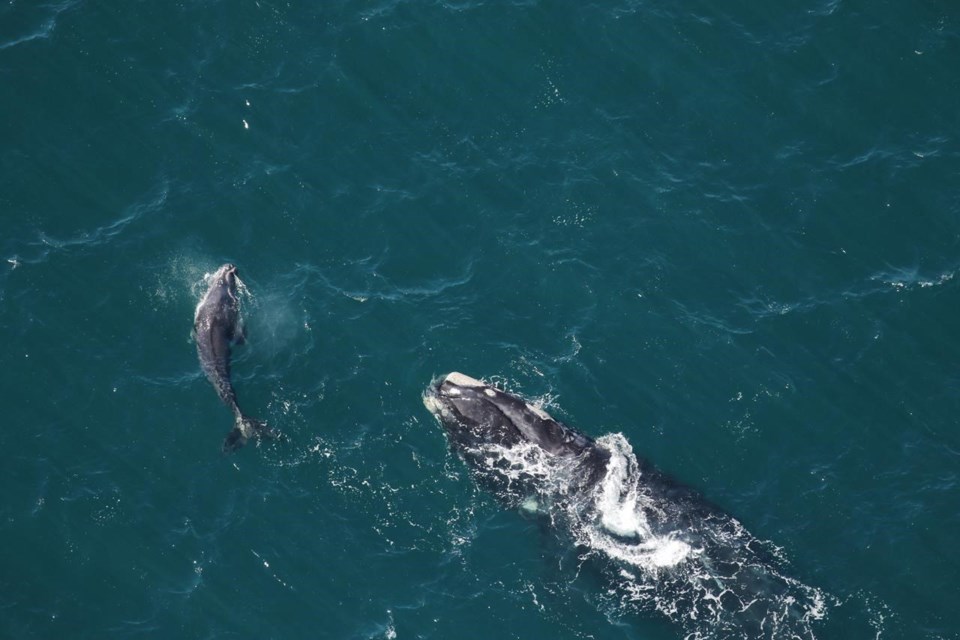HALIFAX — The population of critically endangered North Atlantic right whales isn't declining as fast as it was five years ago, but researchers say the latest numbers show the species is still having a tough time surviving and reproducing.
The North Atlantic Right Whale Consortium issued a statement Monday saying its latest population estimate stood at 340 animals as of last year — a drop from 348 recorded in 2020.
"While it is certainly good to see the slope of the trajectory slow, the unfortunate reality is that the species continues to trend downward," Heather Pettis, research scientist at the New England Aquarium in Boston, said in the statement.Â
The consortium, which includes dozens of conservation, government and industry organizations, says only 15 calves were born in 2022, far below the average of 24 reported in the early 2000s. Eighteen were born in 2021.
As well, the Boston-based consortium determined there were no first-time mothers this season, which supports earlier research showing a downward trend in the number of female whales capable of breeding.Â
Oceana, a Washington-based conservation group, said the latest numbers "confirm the dire situation facing North Atlantic right whales." The group called on Canadian and U.S. officials to take immediate action to protect the species from extinction.
"We need to keep all of the measures in place that we already have, and continue to work to find ways to refine and strengthen measures to protect right whales," said Kim Elmslie, Oceana's campaign director in Canada.
Meanwhile, recent research has found evidence that the remaining right whales are getting smaller, partly because of frequent entanglements in fishing gear, with smaller female right whales producing fewer calves.Â
This year, five whales were spotted with fishing gear attached to them, and at least five others are known to have been previously entangled, showing injuries significant enough to cause wounds. There was also one detected vessel strike in 2022.Â
In 2017, the Canadian government introduced a series of measures to protect the whales after 12 of them died in Canadian waters — mostly from collisions with boats or injuries caused by fishing gear.
Those ongoing measures included increased aerial surveillance, restrictions on shipping lanes, slower speed limits for vessels, temporary fishing ground closures and real-time monitoring using underwater listening devices.Â
Elmslie said these measures have helped reduce the number of collisions with ships and entanglements, but she said more needs to be done.Â
"Right now we're using interim orders and ministerial discretion, which are meant to be a temporary solution," she said in an interview. "It has worked and we have a solid foundation. Now we need to make it more permanent, with permanent funding to keep this program in place."
Between 2017 and 2022, ship strikes and fishing gear entanglements were the leading cause of death and serious injury for right whales.Â
During that time, 11 whales in Canadian or U.S. waters were killed by ship strikes, and nine died after being entangled in gear. Another 14 whales died from unknown causes, according to the U.S.-based National Oceanic and Atmospheric Administration.Â
Boris Worm, an expert in marine conservation at Dalhousie University in Halifax, said the low birthrate numbers are very troubling.
"The reason is that the food quality is poor," Worm said in an interview Monday. "The mothers just don't have babies, or not as often because their bodies can't take that .... They don't get pregnant."
Worm said that wasn't the case in the early 2000s when the population was increasing rapidly. But he said the whales changed their summer migration patterns as climate change affected their food supply, and now they venture farther north into Canada's busiest shipping lanes.
"They keep being killed and are not replacing themselves quickly enough," he said.
Though the overall rate of population decline has recently decreased, the number of right whales is now roughly the same as it was in 2001.Â
Philip Hamilton, senior scientist at the New England Aquarium in Boston, said the population increased by 150 animals between 2001 and 2011, but it levelled off and then a steep decline started in 2017.Â
"That tells us this species can recover if we stop injuring and killing them." Hamilton said in a statement.Â
So far this year, there have been no detected right whale deaths, but scientists remain worried about the species — the most endangered large whales in the world.Â
"While we can be cautiously optimistic about this, we know that only one third of right whale deaths are observed, so it is likely that some whales have died this year that were not observed," Scott Kraus, the consortium's chairman, said in a statement.
It's believed the right whale population peaked at about 21,000 before aggressive hunting drastically reduced their numbers. By the 1920s, fewer than 100 remained because of aggressive hunting. After a ban on right whale hunting was imposed in 1935, the population grew to 483 by 2010.
This report by The Canadian Press was first published Oct. 24, 2022.
Michael MacDonald, The Canadian Press




